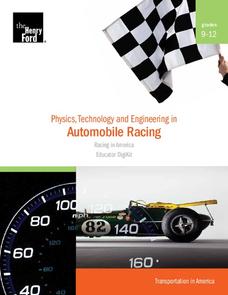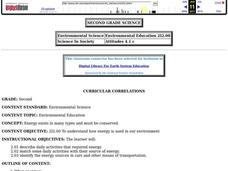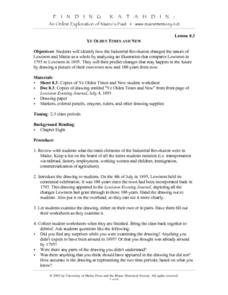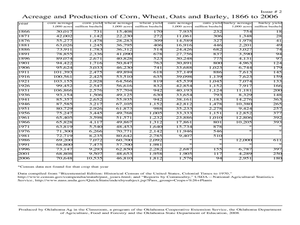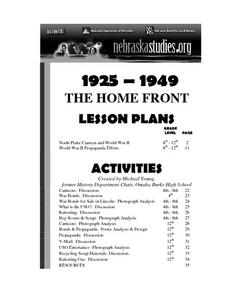Curated OER
A Leader of Salem: Nathaniel Bowditch
Eleventh graders examine the qualities of a leader. For this American History lesson, 11th graders read the story of Nathaniel Bowditch and use it as a catalyst for discussions on leadership and the definition of a hero.
Curated OER
Culture of the Minoan
In this history worksheet, students identify and name various aspects of the Minoan culture. They complete ten different blank shapes that explain their religion, transportation, entertainment, education, government, money, and how they...
Curated OER
The Evolution of Arkansas Elementary Education
Fourth graders interview older citizens to discover earlier educational history. They write essays based on their interviews.
K12 Reader
Transcontinental Railroad
Who built the Transcontinental Railroad and why was it important? Your class can learn about the laying down of these tracks by reading a short passage. Pupils then respond to five questions related to the text.
Curated OER
How Are You Doing With My Crusade?
Students use the Internet site, Past Times, to research the work of a famous woman from the past and then determine the current status of the issue she fought for. They write a story/report about the wonam and the issue.
Henry Ford Museum
Physics, Technology and Engineering in Automobile Racing
Start your engines! This five-lesson unit introduces physics and Newton's laws through automobile racing. Each lesson includes background information, a student worksheet, and an answer key. There are also culminating project...
PBS
Taking A Field Trip
Field trips require a great deal of advanced planning to be successful. Ensure the success of your trips with a step-by-step preparation guide that itemizes before, during, and after activities as well as extension and adaptation...
NET Foundation for Television
1850-1874 Railroads and Settlement
Have you ever wondered how your town was placed where it is? Scholars research the impact the advancement of the railroad due to the passage of the Kansas-Nebraska Act had on the formation of civilization in the Great Plains. Map...
Society for Science & the Public
Easter Islanders Made Tools, Not War
When studying artifacts, especially tools, how do archaeologists determine what the devices were used for? In what ways might researchers' previous experiences influence their perception of an artifact? An article about researchers'...
Curated OER
Environmental Education
Second graders discuss the different forms of energy and their sources. They work with a partner to answer a variety of questions revolving around energy. They develop a scientific attitude about renewable energy.
Curated OER
From Object To Story
Students engage in a study that focuses upon the study of artifacts for the purpose of defining the heritage of family. They conduct research using a variety of resources. The information is used in order to create a personal family...
Curated OER
Travel the Nile
Students create a game board that lists the cities along the Nile River with markers of boats, cars, camels, feet, train, etc.
Curated OER
Bound For Texas
Students examine factors that motivated immigrants to move to Texas. They locate features on the Texas bird's-eye view website, and develop an art or writing project either from a townsperson's or immigrant's perspective.
Curated OER
Comparison of American Colonies
Students explore the lifestyles of the American colonies. They conduct various activities according to their grade level including jigsaw research and creating a poster. Lesson includes primary source readings related to the topic.
Curated OER
Ye Olden Times And New
Students investigate the changes that occurred during the Industrial Revolution by comparing primary source documents from the Lewiston Evening Journal of 1895. They evaluate the document using a guided worksheet and discuss the changes...
Curated OER
Rosa Parks
In this reading comprehension worksheet, students read a biographical story about Rosa Parks. Students answer 4 questions and then summarize the story.
Curated OER
George Washington and the First Census of Agriculture
Sixth graders compare modern agricultural statistics with those that are extracted from a primary source letter of George Washington. They complete worksheets and discuss what they have learned.
Curated OER
Sustainability Project
Students explore alternative energy sources. In this environmental lesson, students discuss alternative energy sources and construct a plan to incorporate an alternative home technology into a bedroom. Students build a model of their...
Curated OER
Westward Expansion - Fur Trade
Students complete a unit of lessons to learn how products reach the market and study the history of the fur trade. In this history and trade lesson, students first learn about the technology that allowed products to reach market faster....
Curated OER
The Lake Champlain Highway
Ninth graders read and color “Boats, Boats, Boats on Lake Champlain.” In this US History lesson, 9th graders listen to more detailed descriptions of the history of boating on Lake Champlain. Students draw a picture of a boat used today.
Curated OER
From the Flintstones to the Jetsons
Eighth graders compare and contrast transportation and agricultural methods in the United States from Colonization to Reconstruction. They, in groups, create and present Ohio Memory Scrapbooks to rest of class.
Curated OER
Trading in the Silk Roads Cities
Students explore elements of trade along the Silk Roads by examining products of various locations along the route, production, influences of resources and environment, challenges of transportation, and economic exchange; students then...
Curated OER
Valley Forge
Students describe how location, weather, and physical environment affect the way people live, including the effects on their food, clothing, shelter, transportation, and recreation. They also describe the lives of American heroes who...
Curated OER
North Platte Canteen and World War II
Students employ primary resources to investigate the rise and decline of a canteen in World War II. The significance of volunteerism and the use of the railroad for troop transportation are examined.







